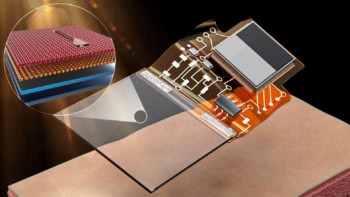This year's Nobel Prize in Physics has been awarded for the invention of semiconductor lasers, integrated circuits and other high-speed electronic devices. Zhores Alferov of the A F Ioffe Institute in St Petersburg, Russia, and Herbert Kroemer of the University of California at Santa Barbara receive half the prize "for developing semiconductor heterostructures used in high-speed- and opto-electronics." The other half goes to Jack Kilby of Texas Instruments "for his part in the invention of the integrated circuits." The prize is worth 9 million Swedish kroner (about £660 000). The Nobel foundation credits this year's prize-winners with laying the foundations for modern information technology and communications systems.
Kroemer and Alferov share the prize for their work on semiconductor heterostructures – devices that contain thin layers of different semiconductors, usually based on gallium arsenide, stacked on top of each other. In 1957 Kroemer, then working at the RCA company in Princeton, published the first proposal for a heterostructure transistor. His theoretical work showed that heterostructure devices could offer superior performance compared with conventional transistors.
In 1963 Kroemer and Alferov independently proposed ideas to build semiconductor lasers from heterostructure devices. Alferov built the first semiconductor laser from gallium arsenide and aluminium arsenide in 1969. Semiconductor lasers are now used in a vast number of applications.
After the transistor had been invented, it was still necessary to solder the different parts of electronic circuits together. In the early 1950s, along with the late Robert Noyce, who died in 1990, Jack Kilby was the first person to realize that the different components in a circuit could be integrated on a single piece of silicon. Kilby’s work has underpinned the entire information technology industry. Kilby also co-invented the pocket calculator.
Zhores Alferov was born in Byelorussia in 1930. After graduating from the Electrotechnical Institute in Leningrad in 1952 he went on to gain his doctorate in physics and mathematics from the Ioffe Institute in 1970. Alferov’s research on III-V semiconductors has spanned the last four decades and he has received many national and international awards. He is currently director of the Ioffe Institute, vice president of the Russian Academy of Sciences, president of the St Petersburg Scientific Center of the Russian Academy of Sciences, and a fellow of the Institute of Physics.
Herbert Kroemer received his PhD in theoretical physics from the University of Göttingen, Germany, in 1952. After spells at RCA, Varian Associates and the University of Colorado at Boulder, he moved to Santa Barbara in 1976. Kroemer’s work has been rewarded nationally and internationally. His current research focuses on superconductor-semiconductor devices.
Jack Kilby earned BS and MS degrees in electrical engineering from the Universities of Illinois and Wisconsin. He joined the Centralab Division of Globe Union Inc in 1947, where he developed silk-screen circuits for electronic devices. He moved to Texas Instruments in 1958, and it was here that he carried out his pioneering work in microchip technology. Kilby has over 60 US patents and has received numerous international awards recognising the impact of his revolutionary work in the field of consumer electronics.


